I wanted to see how replacing 25% of the flour with whole red fife might affect the rise and the quality of this milk bread compared to my previous recent bake. I thought 25% was a good place to start and if this is good I’d consider increasing that whole grain portion to 50-75%. Whole red fife is actually a nice mild whole grain flavour without any of the bitterness I associate with some whole wheats. Although it has good gluten potential, which you can feel while doing folds during bulk, it is fermentation intolerant. I suspect this is due to high natural amylase levels in this particular grain so I would generally avoid adding any diastatic malt to it. Now in this bread I wasn’t too worried about gluten degradation because I fully developed the gluten upfront and I eliminated the overnight cold retard also hoping to reduce any sour tang that an overnight cold retard might add.
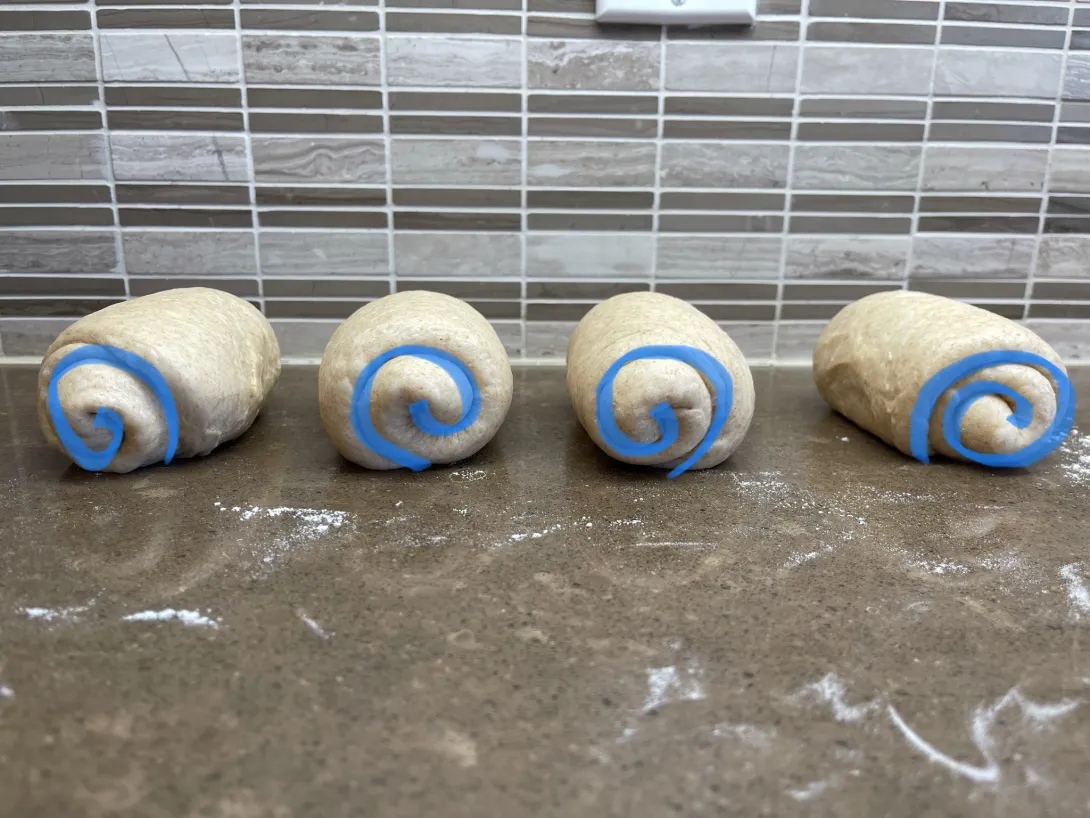
I included the photo above to illustrate something I’ve learned. When you’re placing the rolls of dough into your pan, if you alternate the directions of the rolls, it can help get a better rise. I believe it helps, have a look at my previous bake and the current one today.
For one loaf 9x4” Pullman pan
Ingredients
Sweet Stiff Starter
• 53g bread flour
• 24g water
• 18g light brown sugar
• 18g sourdough starter ~100% hydration
Tangzhong classic 1:5 ratio
• 89g milk
• 18g Whole red fife flour
Dough Dry Ingredients
• (252g) bread flour or 222 g and use 30 g to mix with butter
· 108 g whole red fife
• 59g sugar
• 7g salt
Dough Wet Ingredients
• 149g milk (increased by 10 g for the whole wheat)
• 59g egg beaten (about 1 ⅕ of a large egg)
• 67g butter softene but do not melt. Combine with 30 g of flour to make easier to add to dough.
Total flour = 431 g
Total weight 899 g
Pre-bake Wash
• 1 egg beaten
• 1 Tbsp milk
Post-bake Wash
• 1 Tbsp butter
Instructions
Starter
Mix the starter ingredients in a jar or pyrex container with space for at least 50% growth.
Press down with your knuckles to create a uniform surface and to push out air. This reduces drying and allows you to see actual CO2 aeration over time.
At room temperature, it typically takes 7-9 hours for this sweet stiff levain to be at peak.
Tangzhong
In a sauce pan set on med-low heat, whisk the milk and flour until blended. Then cook for several minutes until thickened, stirring regularly with a spoon or heat-resistant spatula. Let cool in the pan or, for faster results, in a new bowl.
Dough
In the bowl of a stand mixer, briefly whisk the dry dough ingredients, and then add the sweet stiff starter, separating it into 5-6 portions as you add it to the bowl.
Now pour/scrape in all the wet ingredients (including the tangzhong), with the melted butter last. With the dough hook attachment, mix on low speed for a minute, scrape down the sides, and then mix on medium speed for 15-20 minutes. The dough will seem very soft, but as you approach the 15-20 minute mark, it should not stick to your hands and should pass the windowpane test.
Transfer the dough to a lightly oiled bowl, form it into a ball, flip it smooth side up, cover and let rise for 6-12 hours depending on room temperature. If you refrigerate the dough, plan for longer rise times. See photo gallery for approximate dough expansion during the bulk fermentation. I placed the dough into the fridge to chill the dough for about 1.5 hours, this makes rolling the dough easier.
Prepare your pans by greasing them or line with parchment paper.
Scrape the dough out onto a clean counter top. Lightly flour the bench. Press the dough into a rectangle and divide it into four. Shape each tightly into a boule, allow to rest 5 mins. Using a rolling pin roll each ball out and then letterfold. Turn 90* and using a rolling pin roll each out to at least 8”. Roll each into a tight roll with some tension. Arrange the rolls of dough inside your lined pan alternating the direction of the swirls. This should allow a greater rise during proof and in the oven.
Cover and let proof for 2-4 hours (more if you put the dough in the refrigerator). I proof until the top of the dough comes to within 1 cm of the top edge of the pan.
Preheat the oven to 350F and brush the dough with the egg-milk wash.
Bake the loaves for 50 minutes or until the internal temperature is at least 190F. Cover if your loaf gets brown early in the baking process. After 50 mins remove the bread from the pan and bake a further 5 mins by placing the loaf directly in the oven on the rack. If you loaf is super tall like mine was, I gave it another 7 mins with the oven turned off to really ensure that the side crust was firm enough to hold its shape. You can brush the top of the loaf with butter if you wish at this point while the bread is still hot.
After the bread is completely cooled, store it in a plastic bag at room temp for a week or longer.
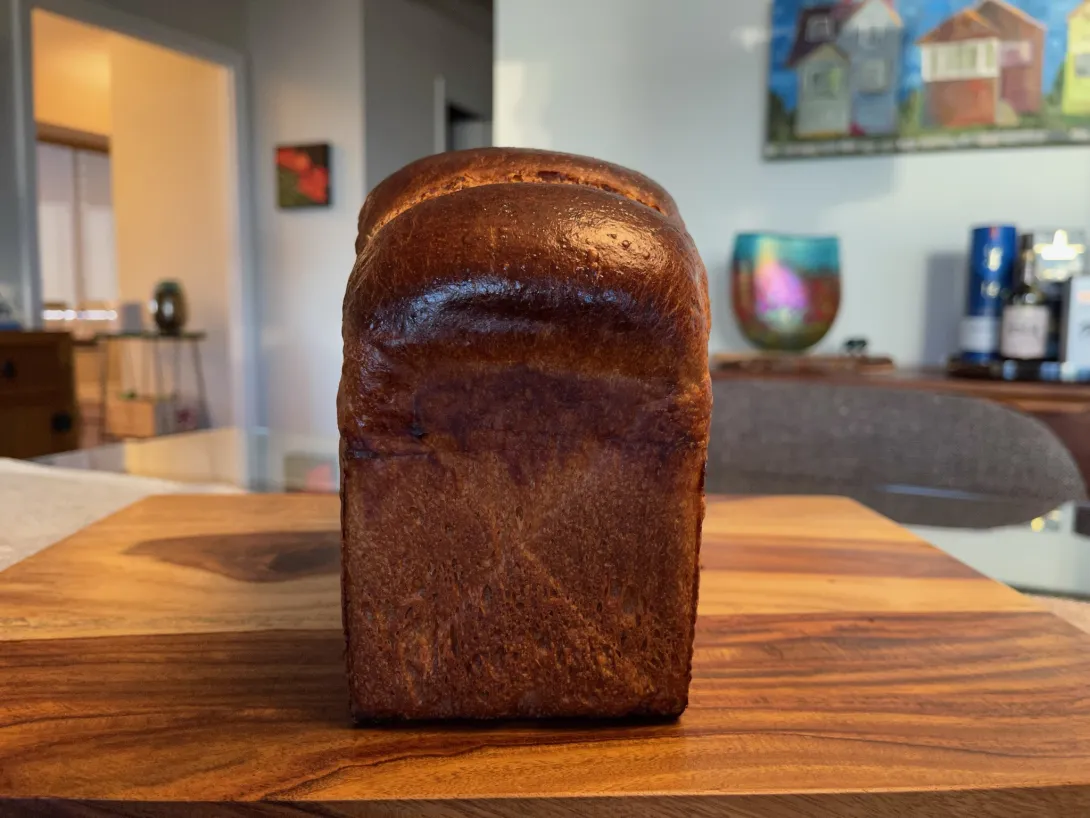
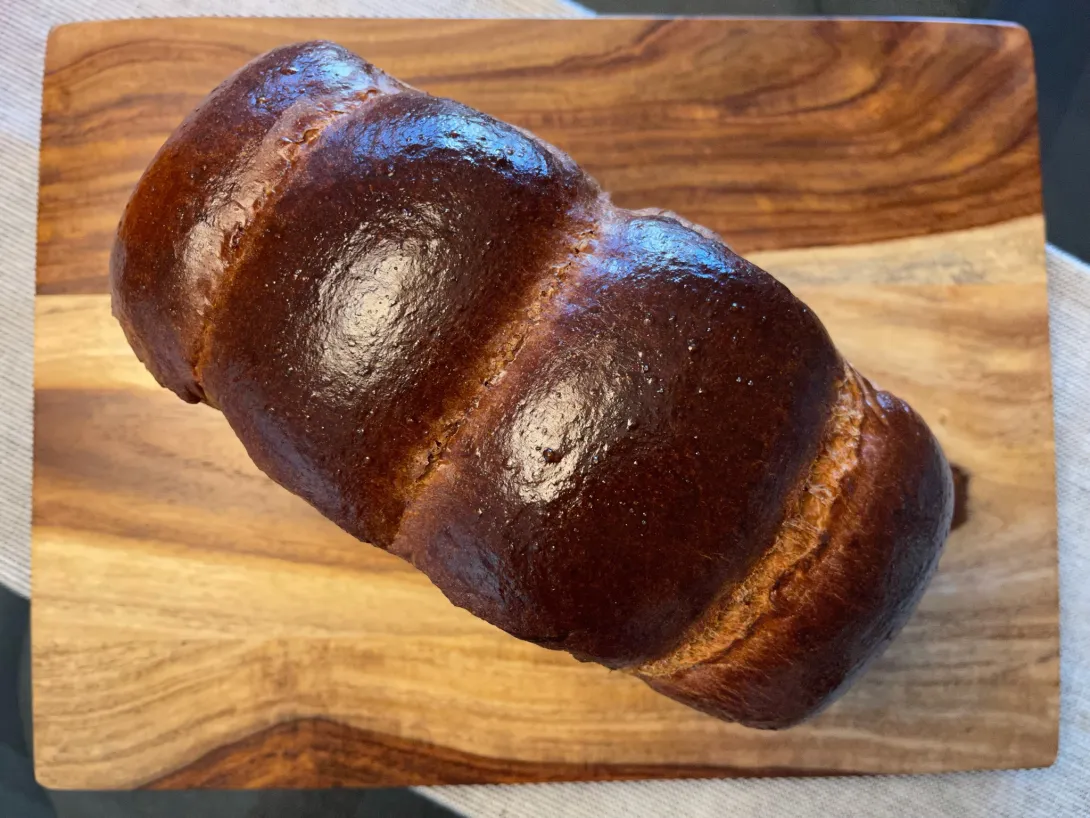
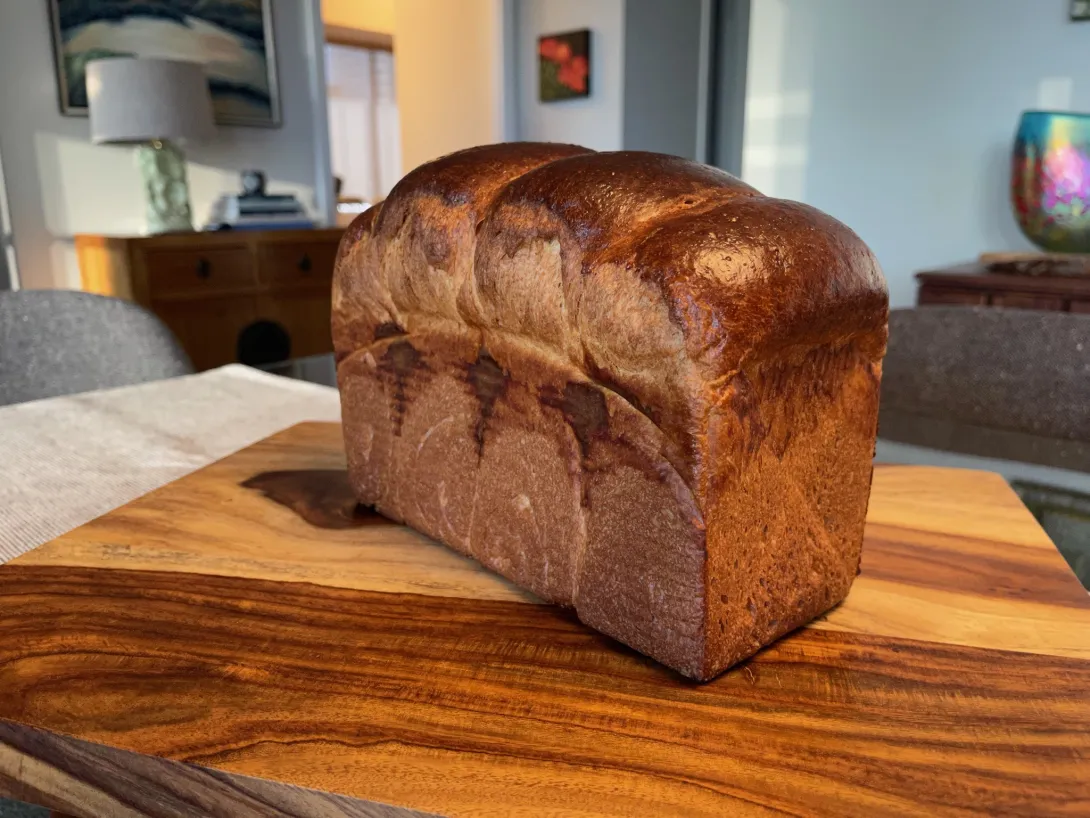
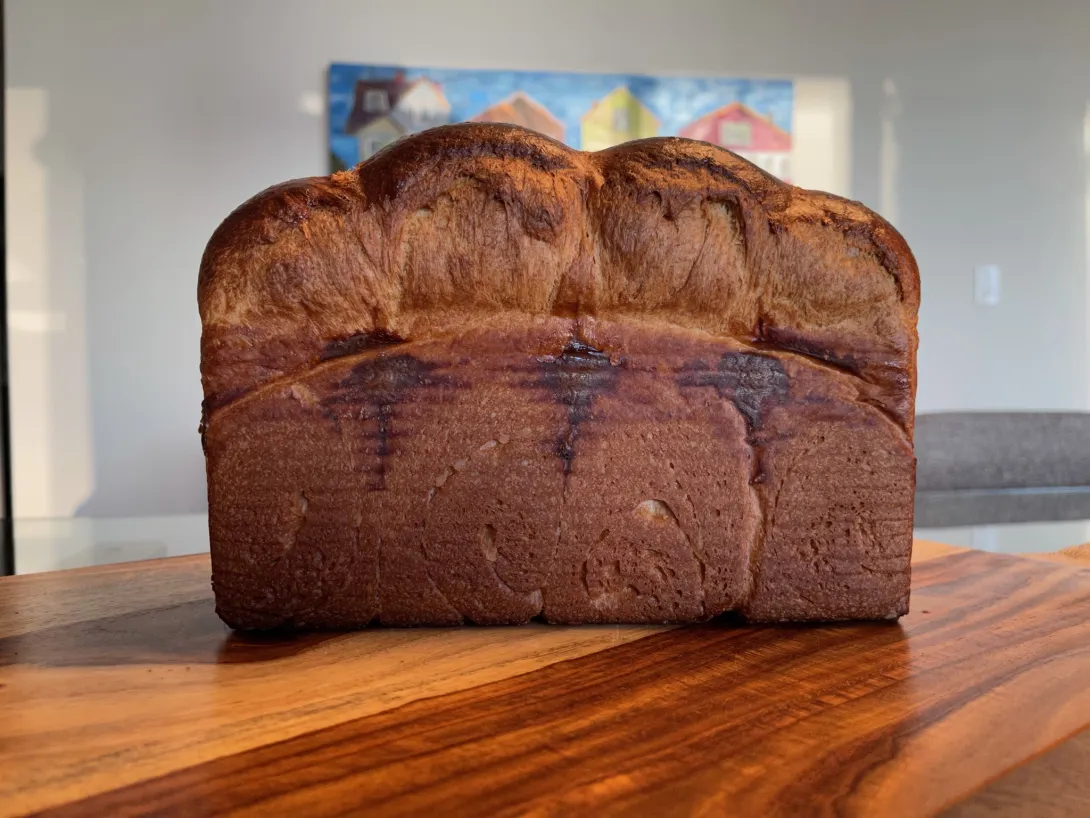
- Benito's Blog
- Log in or register to post comments
I know we just discussed delivery charges but what do you reckon express air-freight to Australia might be?
I've never tried a milk bread and we don't have 'red' wheat at all here in Australia but I think that, once I do sneak some Kamut/khorosan flour in past the rolled-eyes of my partner ("how much flour - all up - do you have?") that might work nicely. I'm sure I would be forgiven if I turned out something even close to this beauty!
d.
Considering that the origins of this style of bread are in Asia, this particular one supposedly in Japan, I suspect that your Australian flours would be perfect to bake this, with or without the whole grain Dan. You need to give it a go especially if your partner prefers white bread. If she/he doesn’t like a sour tang throw a pinch of IDY into the dough to speed up fermentation so the LAB don’t have as much time to produce their acids. Thanks for the comments and your sense of humor. 😉
Benny
Quite possibly - our flours are great for some things; less so for others. I suppose that's like all flours but our industry seems predominantly concerned with how it can sell as much wheat as possible to China and other Asian nations and is not, generally, much concerned with the needs of local artisan bakers - let alone home bakers!
One result of that is the continued* absence of any red wheat as Asian consumers generally (and strongly) preference very white products, whether those are breads or steamed buns or noodles or dumplings.
That said, it's a geographical advantage as white wheat is somewhat less tolerant of unseasonal rain and thus works better in drier areas, like ours. This is probably one reason why white weat is still such a small percentage of US output and what they do have is likely being developed to try and tap into the Asian market.
* - Interestingly, while the preferences of our Asian neighbours may be a driving concern now, the economic conditions for the COMPLETE absence of red wheat was due to British prefence in days gone. Actually, it was less a preference a more an absolute requirment, with corresponding commercial penalties should any grain shipment be found with any red wheat - thus the industry-wide elimination of red wheat!
I didn’t know any of that Dan, thanks for sharing!
In so far as the wheat industry of a country on the other side of the world is relevant at all!
But hey, I find these things interesting as I like to understand why things are the way they are.
To be clear, we do grow red wheat but for feed only. There are a scarce few places that grow red wheat for human consumption but, due to the historically-driven white-washing of the wheat industry, we don't have any good local varieties - or at least none ready for commercialisation. As such, growers who are planting red wheat for use in bread are generally isolated, low yield and usually very expensive 'organic' farms and the flour tends to only be available locally as they may not have the mechanisms for efficient and cost-effective retail distribution and the places that do end up selling to the public are likely usually small, boutique affairs.
Crumb photos of the bread and how we used four slices tonight!
So dinner was tamago sando, or egg sandwiches. My first time making tamago sando although I’ve eaten them while in Japan and loved them. These are not totally traditional in that I used milk bread that had whole grain in it. I also left the crust on because the crust is delicious as is the bread. This loaf with the addition of whole red fife brings a more wheaty flavour to the bread than previous loaves without. I actually think this loaf is better tasting. I would consider reducing the sugar in the future when baking these milk bread. Also note that my soft boiled eggs over cooked and ended up more hard boiled than soft. 🙁
Japanese Egg Salad Recipe
Ingredients for one sandwich
2 large eggs
2 tbsp kewpie mayo (addictively delicious, better than plain mayo, much more umami)
1 tsp milk/cream
1/4 tsp kosher salt
1/4 tsp sugar
Butter room temp
Instructions
Hard boil your egg.
For the whole egg in each sandwich soft boil your egg.
Remove the shell and then cut the hard boiled eggs in half. Scoop out the yolks and place into a bowl. Combine Kewpie mayo, milk/cream, salt and sugar with the yolks. Using a fork mash and mix until smooth. Dice the whites then fold to combine.
Butter your Hokkaido milk bread.
Spread your egg salad over one slice of bread leaving a depression in the center of the bread. Into the depression place one shelled soft boiled egg. Place the other slice of buttered bread on top and pressure together. Finally cut your sandwich in half through the soft boiled egg. Enjoy!
Definitely looks like your alterations to the 'standard' milk bread increased the 'breadiness' of this and made it more substantial - both solid and worthwhile improvements in my book.
Also it has an actual crust, rather than just a 'shell', as is usual on the milk breads I have seen. Again, in my books, that's an improvement.
Well, maybe not if you're going to use it for a fruit sando but for savoury? Definitely!
Thank you very much Dan. I’ll continue to adjust this recipe, like you I like to tinker with recipes to see what else I can change about them that might make them better in some way. Maybe a bit more whole grain and less sugar, those would be the adjustments for the future.
Thank you for sharing the milk bread and egg salad recipes, Benny. I used to make ramen eggs for noodles or rice. I wonder if I could incorporate your methods into a ramen egg sandwich. :D
- Christi
Oh I like how you think, a ramen egg would add another dimension to a tamago sando and would compliment the flavours so well. Yes there is more bread which I’ll use to make tomato sandwiches tonight for dinner. Let me know when you want to swing by for your tamago sando. :)
Benny